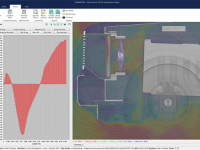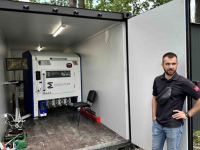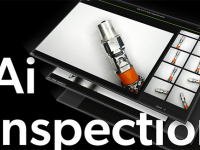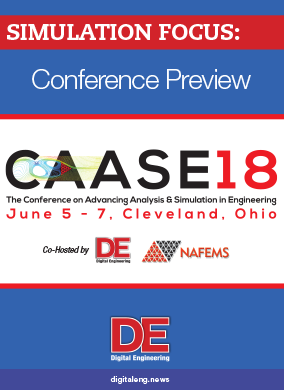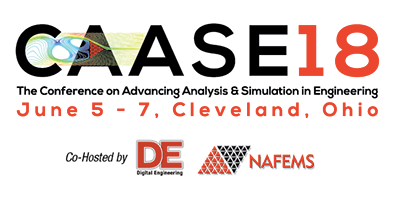Simulation Focus: Conference on Advancing Analysis and Simulation in Engineering (CAASE) Preview
The CAASE18 (Conference on Advancing Analysis and Simulation in Engineering) kicking off June 5-7, 2018 on the south shore of Lake Erie in Cleveland, OH plans to take the engineering analysis community by storm.
May 8, 2018
At Digital Engineering, we’re lucky enough to see all the technologies used in upfront product design and development—and many that extend beyond into executive management, operations, logistics and production. Our coverage provides us with a drone’s-eye view of engineering, making it easy to see how different companies are capitalizing on—or struggling with—the implementation of simulation technologies into an efficient workflow.
From our vantage point, we can see the long trial-and-error cycles of iterate, design, prototype and test that could be reduced by simulation. However, we also see the common bottlenecks those who implement simulation strive to overcome: there are too few simulation analysts per CAD engineer; complex, high-fidelity simulations take a long time to run; software licensing can be confusing and expensive; government regulations and certifications are slow to recognize simulation results; and there is a steep learning curve for simulation software. Those bottlenecks all have one solution in common: access.
Get Access to Simulation Solutions
Experts from all corners of engineering are making strides to improve that access. Academia and industry are working together to ensure software is easier to use, more people have a firm grasp of analysis, and the expertise of experienced simulation analysts can be distributed throughout an enterprise. Computing hardware manufacturers and high-performance computing service providers are working with simulation software providers to enable faster simulation run times—whether on the workstation or via a private or public cloud—at various levels of software licensing investments. Independent and vendor-provided consultants and training abound to help integrate simulation software more effectively into the unique workflows of different organizations.
In short, real advances are being made in extending the reach of analysis and simulation by addressing bottlenecks and breaking down the barriers that once relegated the benefits of simulation to a select few. Those benefits include faster time to market, fewer expensive physical tests, more time to explore “what-if” scenarios that can lead to innovations, more confidence in new-to-you design and manufacturing technologies like lightweighting, generative design and additive manufacturing, and improved collaboration.
The Devil’s in the Details
But that’s the high-level view. To take advantage of those benefits, you have to get down to the details that are particular to your own workflow. To answer the: “What can simulation do for me?” question, you have to engage with people who have already been there and done that. Those people will assemble at the Conference on Advancing Analysis & Simulation in Engineering (CAASE) June 5-7 in Cleveland, Ohio. That’s why DE teamed up with NAFEMS, the international association for the engineering modeling, analysis and simulation community. NAFEMS has a proven track record of bringing experts from industry, government and academia together at its NAFEMS World Congress and its regional events, including in the Americas.
If you’re relatively new to simulation, we hope you’ll join us to take advantage of the knowledge shared during the presentations and the free training sessions—some of which are directed at design engineers who are not simulation experts—in addition to networking with simulation leaders. In addition to the technical presentations, there are many that focus on the business benefits and challenges of simulation that can help you build a return-on-investment case for implementing simulation more fully into your product design and development process.
If simulation is an integral part of your workflow already, there is certainly plenty more to learn. You can delve into the specifics of particular processes, such as fatigue analysis, composite finite element analysis (FEA), non-linear FEA, or turbulence modeling, or the physics involved in joints and connections, for example. With 200 presentations at CAASE, you’re sure to find something to improve your processes. Plus, we hope you’ll share your expertise with others during the many opportunities for networking at the event.
We look forward to meeting you at CAASE. We will, of course, cover the event live via Twitter (@DEeditor) and follow up with articles here and in Digital Engineering magazine, but we’d love to engage with you in person. Stop by our booth at CAASE to share your story, tell us what topics you’d like to cover and how we can help learn about the technologies that are transforming design engineering today.
Latest News
